Fluids have no form. They flow, they change shape, and because they have very low density they can’t support any mass. Now sand isn’t a fluid, but here in the Sam, out in the middle of nowhere, it sure is behaving like one. I scoop up a handful, but when I open my fingers even slightly, it runs right out. This isn’t like moist beach sand at all. And when the wind picks up, it even flows, with ripples and circular eddies.
I trudge up one of the tall dunes, my feet sinking in, all the way to my ankles. And the higher I go, the softer the sand becomes. This is going to be tough. That piece of metal behind me weighs 15 tonnes; it will sink like the Titanic.
There are two fundamental problems here. Number one is staying ‘afloat’, and the only way to do that is to distribute weight. And then there’s the difficult job of finding traction. Bunch the sand up under your wheels and it will compress and you can move. But how’s that even possible here?
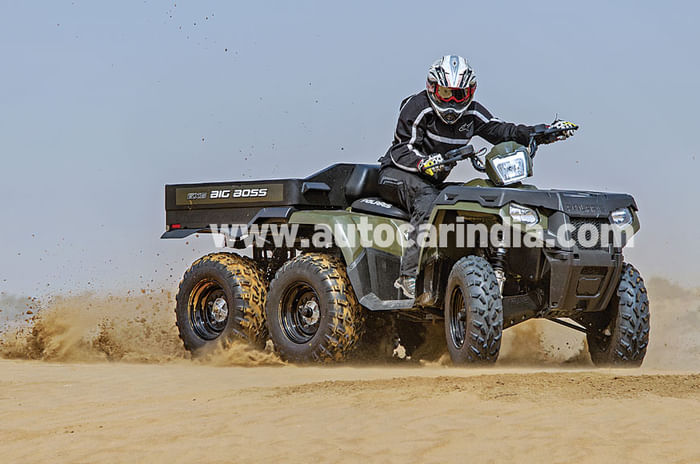
Now conventional wisdom says a 4x4 is absolutely the best way to tackle sand. But I can’t help marvel at how easily the inch-long scarab scampers over the golden sand on its six legs. It falters at times, and often a couple of its legs slip, but because the others are still pulling forward, it continues moving. And that’s exactly why a 6x6, despite the extra weight of an additional axle, should be better.
It’s time to drive up to the area where I’m meeting Rahul, who’s also with a 6x6. Thing is, he’s riding a quad-based Polaris and is expecting me to turn up in something similar. He’s going to fall over when he sees this 15-tonne monster bearing down on him. And bear down on him I will; I plan to drive right up to him before I stop.
THE BEAST MAKES ITS MARK
I don’t want to get stuck before we even get going, so I’m going to skirt around the periphery of the dunes. Even a regular truck needs a big step up to the cab, but this one is more like a hike. Starting up is easy enough, but what I have to pay attention to are the width and the length. And then there are the eight gears. I ask the man from Ashok Leyland if I can skip gears, and he just shrugs. “No problem sir,” he says, totally nonplussed. So I start the beast and head out.
It isn’t smooth, there’s a lot of resonance and loads of diesel clatter, but compared to a regular truck engine, this 360hp common-rail diesel is quite refined.
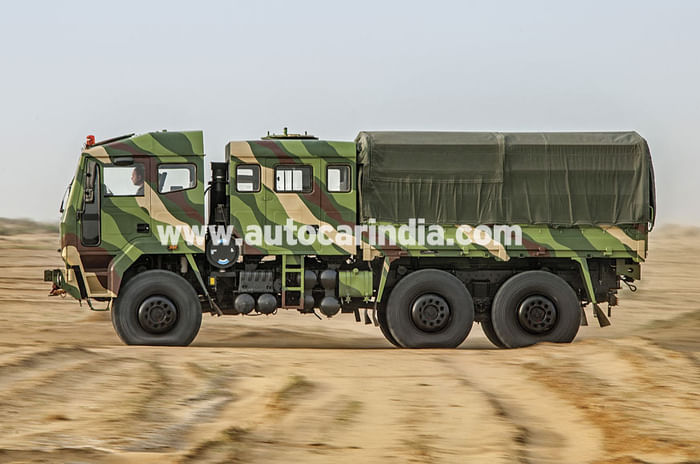
What takes some getting used to is the narrow powerband; truck engines like this max out at 2,500rpm. And peak power is even lower. This is due to the extremely heavy engine components and massive reciprocating masses. So I let it growl to around 1,400rpm, double-declutch and shift to the next gear. I start in first, go up to third and then slot fifth. And apart from some severe ‘head-nodding’ due to my poor clutch action, everything else seems okay. My passenger smiles. We are off the highway, on to a dirt road, and looking back in the rear-view mirror, I see the double rear axle leaving its imprint in the sand like a tracked vehicle. Crazy.
IT TURNED, EVENTUALLY
Unsurprisingly, I feel none of the ruts and stones below. We must be riding on at least a foot and a half of air, and with six wheels, the huge off-road tyres, and weight of the truck, pretty much everything is being steamrolled. The rear axles feel supple and malleable because the load each axle has to carry is halved. And with truck riding on so much air and rubber, the ride at speed is actually super.
I stoke it up to around 70kph and this feels quite effortless, but then come a few scary moments. You’ve heard of turbo lag, but this thing at speed seems to have steering lag. Of course, I don’t mean literally, but there’s so much momentum here, it just wants to carry on going straight before finally turning. And the steering is slow.
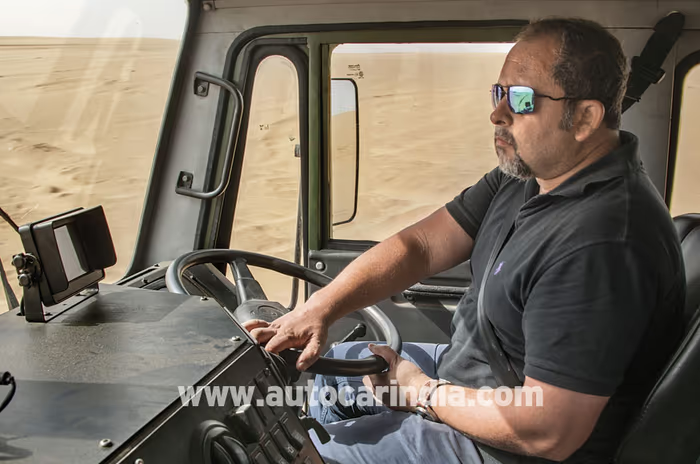
The big manhole-sized wheel is pretty driver friendly but there are many, many turns lock to lock, and that is an issue in tight turns initially. Still, this over-assisted power steering is light and easy, even if you have to make those big sweeping arm movements.
UNDER PRESSURE
Then, finally, the dunes. And up ahead, Rahul, sitting on the Polaris 6x6, looking into the distance, bored. Guess he’s waiting for me. I have to lower the tyre pressure for the dunes, but if I stop I’ll lose the element of surprise. The tyres are currently in highway mode, at around 70psi, but for sand, we have to use the on-board system to drop them to around 20. Still, the man from Ashok Leyland says it’s okay to drive up the initial bit.
So, I motor straight in, select a low gear and start chugging up the dune. Rahul looks on in interest, but can’t see inside. “Wow, an army truck in full battle camo,” he must be saying. Out comes the phone to take a picture. And still, I keep climbing, closer and closer. The FAT 6x6 is now struggling to put power down and the wheels are sinking. But on instruction, I keep my right foot in and go closer and closer, the engine now quite deafening at around 2,000rpm. Luckily, the gradient slopes off and, once on the level, we race forward. When I’m 10-15ft away, I slow right down but keep creeping. Rahul thinks he is about to be thrown out of Rajasthan by the Indian Army. I finally stop only a foot or so away, and begin the process of deflating the tyres, the FAT 6x6 hissing and popping in protest after the hard climb, cooling fans ablaze and engine belting out heat.
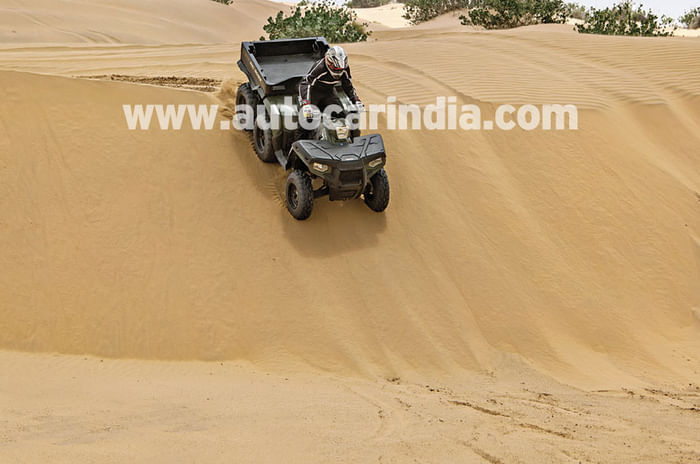
Then he sees me, laughing my head off. “It’s a 6X6,” I yell out. “Where the hell did you get that?” he screams back, still wide eyed, “my heart is still racing”. “It’s a long story. But how’s this little ripper?” I ask pointing to the Polaris. “It has 51hp and can tackle any dune here. And that’s without going into low,” he says. From all the tyre tracks, I can see he’s had his fun.
FAT VS BIG BOSS
What makes this Polaris special is the tremendous power-to-weight ratio and the 6x6 traction. At the heart of the Big Boss is a 760cc, V-Twin motor that is capable of sending 51hp to all six wheels; think a motorcycle engine with a scrambler tune. A switch on the handlebar lets you select which wheels you want powered – rear four or all six. Drive goes to the wheels via a CVT gearbox. We lift the loading bay to check out the suspension and axles. The all-round independent suspension is clearly visible and this 6x6 even has a lockable rear-differential, a limited-slip-differential and low range to ensure it can climb some unimaginable terrain.
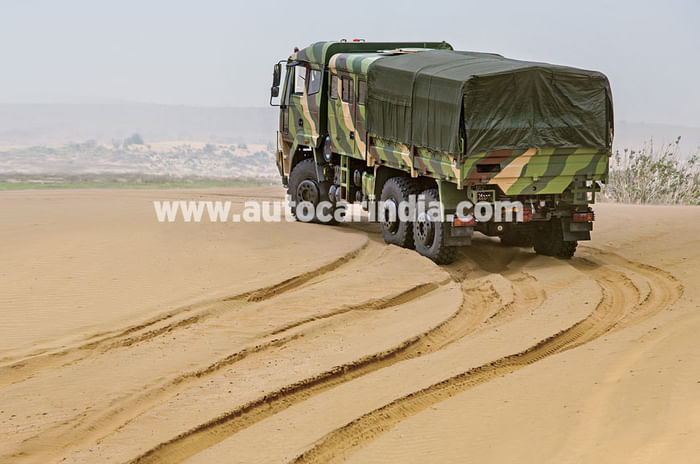
Next, it’s the turn of the FAT 6x6. We are dwarfed by its height as we walk around, and those off-road Michelins are just huge. Also, now with the air pressure down to around 25psi, the footprint of the tyres is just massive. But what does FAT 6x6 mean? Well, FAT stands for Field Artillery Tractor. Its primary role isn’t to carry load in the back but to pull the 12-tonne, 155mm Bofors howitzer. Almost everything on it has been custom-designed to do this. The Neptune N6 engine has been given a larger radiator and is designed to work under heavy loads, even above 50deg C. There’s a special butterfly valve in the exhaust to provide extra engine braking on downhills (five times more power than a regular commercial truck). This is done to save the brakes on long descents. There’s a high-capacity clutch and even an extra power steering pump if the primary one fails. And to deal with the turbo spinning too fast and damaging itself at high altitudes, say at 18,000ft, there’s a tuned blow-off valve. Leyland has even given the truck a winch at the rear that can pull 10 tonnes, and a crane that can lift 2,700kg to help load the truck from ammunition pits. The 6x6 has a low range, limited slip differentials and locks for individual transfer cases. Also, if needed, it can wade through more than 1.5m of water.
MORE FUN UNDER THE SUN
“You lead and I’ll follow,” I tell Rahul. But it immediately becomes apparent – the Polaris is massively agile and the FAT 6x6, well, just isn’t. So, while I drive what looks like an easier path through the dunes and over the saddles and cols, Rahul zips up and around the crests. One minute, he’s above me, ripping along the top of a dune, the other, he’s making a quick descent right alongside. And that V-Twin sounds like a chainsaw with a sports muffler on it.

I’m now in low range in the truck, so the powerband is even narrower, and I’ve even more work to do with the gearbox. The optimum powerband is now no more than 600 or 700rpm wide, and then there’s the fact that I have to keep the boost up when I’m climbing. Initially, the descents are really scary, as the 6x6 drops one shoulder and then the other. I have to be aware of how and where the mass of the truck is shifting. And after getting stuck on a couple of inclines and rolling back, I learn to plan ahead and plant my foot on the way down to get the turbo spinning, as crazy as that sounds. But soon, the 6x6 feels at home in this semi-fluid environment and I’m driving with more speed and confidence.
Speed when compared to Rahul, however, is only relative. The 6x6 Polaris is finding so much traction on the way up the dunes, Rahul can get the front wheels in the air. This, of course, means more speed, and even more and soon he’s leaping up, all six wheels in the air. Sand, however, means all landings are relatively soft, and then, once he selects 2x4 (actually 6x4) and sends power only to the rear quartet of wheels, some tail-out action is what he’s treated to. The power slides aren’t long because there’s a lot of traction at the rear, but the tail does step out nicely if you flick it.
We stop for some water and to give our mounts a break, and helmet off and riding suit open, Rahul is chuckling. It must be hot inside the helmet. It’s 50deg C outside and the sweat is running into my eyes, but I’m in an air-conditioned cabin and he’s wearing a ‘blanket.’
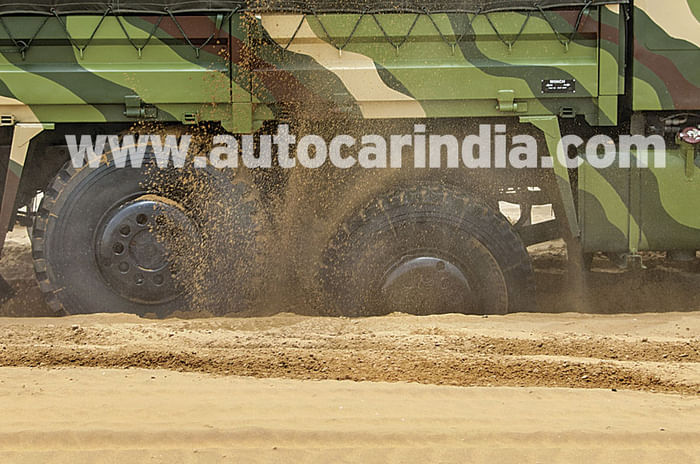
“You’re obviously having a blast,” I start. “To be frank, it felt a bit weird sitting in a vehicle with a handlebar but not having to balance it. And that thumb-operated accelerator is initially difficult to get. But soon everything feels natural, and riding or driving or whichever it is, becomes natural, and that’s when you can really start to push the limits and have a blast. I never imagined it could be so much fun,” he says.
“How about some 360s?” I ask, winding him up a bit. “There’s a bit too much grip in the rear, but let me try.” And sure enough, after some trial and error, we do get a sort of jagged circle, and plenty and plenty of laughs.
TRENDING NOW
So, it’s pretty clear. In sand, when traction and surface area are important, a 6x6 is superior to a 4x4. There literally was nowhere we couldn’t go if we were smart about it. The ease at which we executed climbs and the way both took the difficult bits in their stride was just amazing.
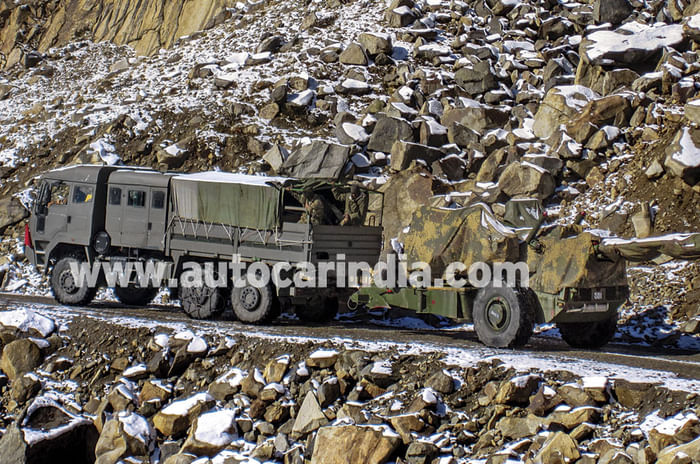
If you have a place near the beach or even in the mountains, the Polaris will make for a fun tool. At Rs 15 lakh, it is a bit expensive, but it can go places and do things no car or bike can. The FAT 6x6 is a bit more difficult to justify as a rational purchase, but if you live in a difficult neighborhood and want to walk softly, but carry a larger stick, this could be the vehicle for you. And Bollywood stars, just imagine, you can go anywhere without being harassed, and your entire security detail can travel with you. You can even get someone in from ‘props’ to make a Bofors 155 replica for you. Wouldn’t that be neat? Hummer? Hah.
| Technical specifications | ||
|---|---|---|
| Ashok Leyland FAT 6x6 | Polaris Sportsman Big Boss 6x6 EFI | |
| Price (est) | Rs 85 lakh | Rs 15 lakh |
| Length | 8690mm | 2844mm |
| Width | 2500mm | 1168mm |
| Height | 3250mm | 1194mm |
| Wheelbase | 4660mm | 2019mm |
| Engine | 6 cyls, 7800cc, turbo-diesel | V-twin, 760cc, petrol |
| Power | 360hp at 2200rpm | 50hp |
| Torque | 1400Nm at 1300rpm | 65.8Nm at 5800rpm |
| Gearbox | 8-speed manual | CVT automatic |
| Tyre size (f/r) | 14.00 R20 | 25/8 R12 / 12/11 R12 |
| Kerb weight | 14000kg + 12000kg (Bofors) | 480kg |
Shapur Kotwal & Rahul Kakar
















































